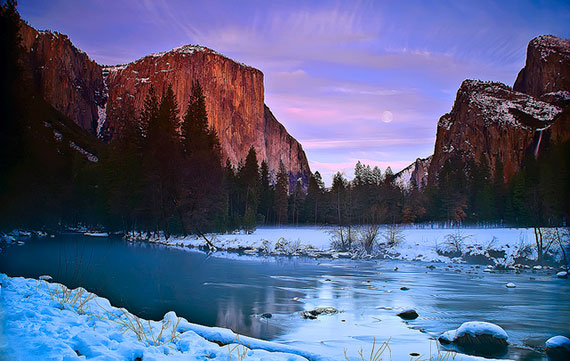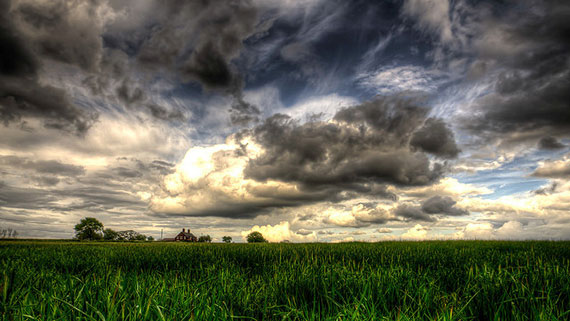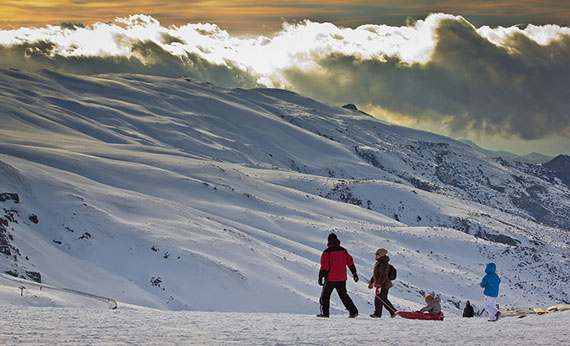There are many factors that go towards creating great landscape photography. Some of the most popular and successful landscape photos usually follow a few of the elements described in this article while ignoring a others in order to create a unique scene. Here are a few items to consider while setting up your shot.

Photo by Anita Ritenour; ISO 100, f/22.0, 2-second exposure.
Lens
Using an ultra wide angle lens is standard, in order to pack us much of a scene as possible into the picture. However, it’s worth experimenting with a telephoto lens too.
Composition
Pay attention to the rule of thirds, i.e. break the image down into a nine square grid, then place any lines in the picture, or focal points, along the lines of the grid.
Focal/interest points
Placing a person, trees, or a building in the foreground can give a focal point and add a sense of scale to an image.
Light
Some landscape photographers never shoot during the day, only at dawn and dusk when the light can strike life into a landscape. It’s not just the reds and pinks of sunrises and sunsets that can create drama, but the golden light of a low sun can warm a scene and create surprising textures and patterns thanks to its low angle. Similarly, storms, mist, thunderous clouds and dark skies can be much more exciting to work with than a sunny day or a beautiful sunset.

Photo by Jamie Barlow; ISO 100, f/11.0, 1/160-second exposure.
Depth of field
When using an SLR, or a digital SLR, combine a slow shutter speed with a small aperture to make sure your photograph has sharp focus up to the very edges. For this you will need to ensure your camera is steady as any handshake can create blur. The obvious solution is a tripod or if you don’t have one try to find something on which to rest the camera.
Exposure
Because the sky is usually very bright and the ground not so, this presents all cameras with exposure issues. If you can, then using a graduated filter will help to even out the brightness.
Location
Walk around the location to find the best place from which to take a shot. Time spent preparing is never time wasted, especially when you find a more interesting point of view to shoot from. Wander around, get down low or climb a tree to find that interesting vantage point.
Atmosphere
Shooting in black and white can produce some dramatic landscape images. If shooting film and you have two cameras, you could simply switch cameras to the one loaded with black and white film. Alternatively, with a digital SLR camera, it is simple convert it to monochrome in Photoshop afterwards.
Sky
In most landscape shots, either the foreground or the sky will dominate. If the sky isn’t particularly dramatic, place it in the upper third. Conversely, if the sky is full of interesting colours and cloud shapes, place the horizon in the bottom third.

Photo by Hernán Piñera
Movement
Few landscapes are as truly still as we might imagine. Birds flying through the sky, clouds blowing, water running and waves in the sea are all examples of potential motion in landscape shots. Incorporating motion can add drama and focal points to a photograph, although it will mean that you will probably need to employ a longer shutter speed (up to a few seconds). Because this will mean greater exposure, you will have to use a smaller aperture or an appropriate filter.
About the Author:
Miranda Wilson writes about Digital SLR Photography for Calumet Photographic.
Go to full article: Landscape Photography Elements
What are your thoughts on this article? Join the discussion on Facebook
PictureCorrect subscribers can also learn more today with our #1 bestseller: The Photography Tutorial eBook
The post Landscape Photography Elements appeared first on PictureCorrect.
from PictureCorrect https://ift.tt/3al9hwG
via IFTTT






0 kommenttia:
Lähetä kommentti